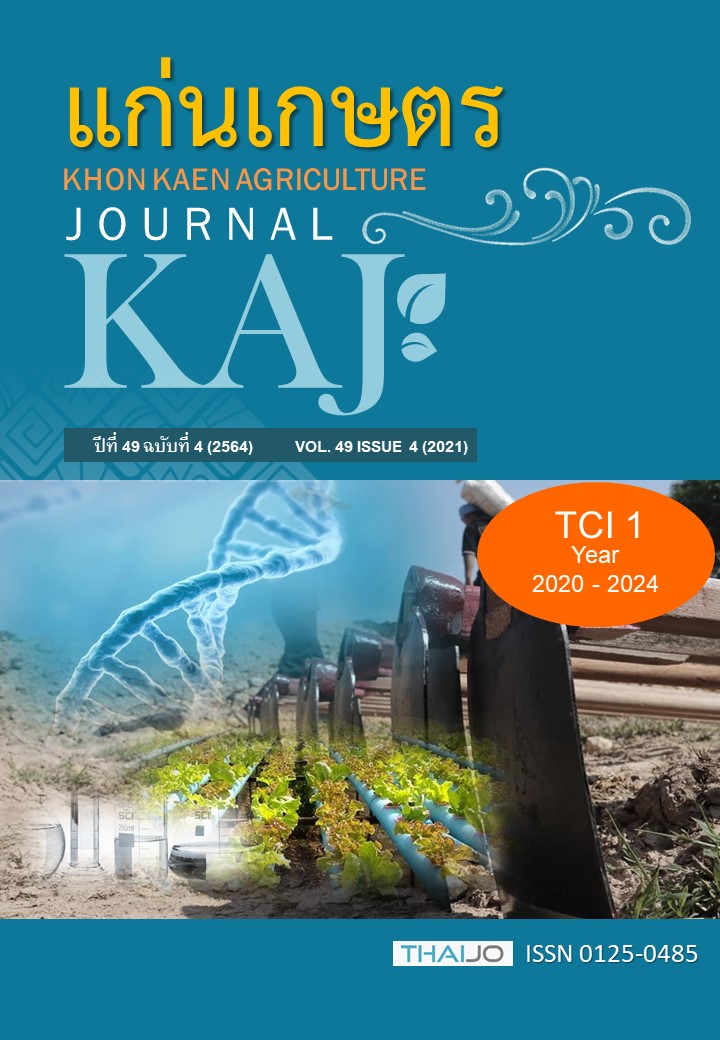Prey preference and predation efficacy of Sycanus collaris (F.) (Hemiptera: Reduviidae) on Tenebrio molitor (L.) (Coleoptera: Tenebrionidae)
Main Article Content
บทคัดย่อ
An assassin bug, Sycanus collaris (F.), has records to control pests in teak, marigold, and tea and has shown potential as a biological agent. Although the predator can be mass reared on alternative prey, Tenebrio molitor (L.), effects of different sizes of yellow mealworm to S. collaris preference, development and survival remains unknown. Hence, small, medium and large sized-larvae and pupae of yellow mealworm were offered to second- to fifth instar and adult S. collaris using choice test. Overall, the predator seemed to prefer larger prey as they grew. The choice-test experiment revealed that the most preference prey of 2nd, 3rd, 4th and 5th instar were small larvae (55%), medium larvae (33%) and pupae (33%), large larvae (40%), and medium larvae (80%), respectively. Both female and male attacked most frequently on large larvae (56% and 44%, respectively). In no-choice test, four prey choices did not affect developmental time in 2nd to 4th instar, but 5th instar grew faster when fed on pupae than medium larvae. Pupae enhanced female lifespan but did not affect male lifespan. Moreover, the findings indicated that S. collaris was expected to have a higher effect on the suppression of small sized-pest populations. Feeding each predator stage with their preferred prey size can improve feeding capacity, survival and later likely to increase reproduction output which is advantageous to the mass rearing program. Understanding the effect of different alternative prey sizes on the predator development and survival will provide evidence whether their preferred prey choice is suitable for the predator and may also provide implications on the predator feeding preference in the field after being released.
Article Details

อนุญาตภายใต้เงื่อนไข Creative Commons Attribution-NonCommercial-NoDerivatives 4.0 International License.
เอกสารอ้างอิง
Ambrose, D.P., and G. A. Kumar. 2016. Reduviid predators. P.217-257. In: Omkar. Ecofriendly Pest Management for Food Security. Academic Press.
Cogni, R., A.V.L. Freitas, and B.F. Amaral Filho. 2002. Influence of prey size on predation success by Zelus longipes L. (Het., Reduviidae). Journal of Applied Entomology. 126: 74-78.
Eubanks, M.D., and R.F. Denno. 2000. Health food versus fast food: the effects of prey quality and mobility on prey selection by a generalist predator and indirect interactions among prey species. Ecological Entomology. 25: 140-146.
Grundy, P.R., and D.A. Maelzer. 2002. Augmentation of the assassin bug Pristhesancus plagipennis (Walker) (Hemiptera: Reduviidae) as a biological control agent for Helicoverpa spp. In cotton. Australian Journal of Entomology. 41: 192-196.
Hohberg, K., and W. Traunspurger. 2005. Predator - prey interaction in soil food web: functional response, size-dependent foraging efficiency, and the influence of soil texture. Biology and Fertility of Soils. 41: 419-427.
IBM Corp. 2015. IBM SPSS Statistics for Windows, Version 23.0. Armonk, NY: IBM Corp.
Jamjanya, T., N. Siri, and S. Phanphinit. 2014. Life history of assassin bug, Sycanus collaris (Hemiptera: Reduviidae) and its efficacy to control insect pests. Khon Kaen Agriculture Journal. 42: 130-135.
Jaworski, C.C., A. Bompard., L. Genies., E. Amiens-Desneux, and N. Desneux. 2013. Preference and prey switching in a generalist predator attacking local and invasive alien pests. PLoS One. 8: e82231.
Maneerat, T., and P. Sakarind. 2018. Potential mass production of assassin bug, Sycanus collaris F. (Hemiptera: Reduviidae) using various stages of Tenebrio molitor L. (Coleoptera: Tenebrionidae) as food. Khon Kaen Agriculture Journal. 46: 195-200.
Morales-Ramos, J.A., M.G. Rojas, K.S. Shelby, and T.A. Coudron. 2016. Nutritional value of pupae versus larvae of Tenebrio molitor (Coleoptera: Tenebrionidae) as food for rearing Podisus maculiventris (Heteroptera: Pentatomidae). Journal of Economic Entomology. 109: 564-571.
Pravalika, K., T. Umamaheswari, and C. Shanker. 2016. Olfactometer studies on preference of Rhynocoris marginatus Fabricius to three lepidopteran preys. Pest Management in Horticutural Ecosystems. 22: 28-33.
Rajan, S.J., N. Suneetha, and R. Sathish. 2017. Biology and predatory behaviour of an assassin bug, Sycanus collaris (Fabricius) on rice meal moth, Corcyra cephalonica (Stainton) and leaf armyworm, Spodoptera litura (Fabricius). Agricultural Update. 12: 1181-1186.
Rosenheim, J., and L.R. Wilhoit. 1993. Predators that eat other predators disrupt cotton aphid control. California Agricuture. 47: 7-9.
Sahayaraj, K. 2012. Artificial rearing on the nymphal developmental time and survival of three reduviid predators of Western Ghats, Tamil Nadu. Journal of Biopesticide. 5: 218-221.
Sahayaraj, K. 2014. Reduviids and their merits in biological control. P.195-214. In: K. Sahayaraj. Basic and Applied Aspects of Biopesticides. Springer, India.
Sahayaraj, K., and K. Sivakumar. 1995. Groundnut pest and pest stage preference of a reduviid predator Rhinocoris kumarii ambrose and livingstone (Heteroptera: Reduviidae). Fresenius Environmental Bulletin. 4: 263-269.
Sarkar, S., A. Babu, K. Chakraborty, and B. Deka. 2019. Study on the biology, feeding behaviour and predatory potential of Sycanus collaris (Fabricius) (Heteroptera : Reduviidae), a new predator of Hyposidra. International Journal of Current Advanced Research. 8: 19258-19262.
Tomson, M., K. Sahayaraj, V. Kumar, P.B. Avery, C.L. McKenzie, and L.S. Osborne. 2017. Mass rearing and augmentative biological control evaluation of Rhynocoris fuscipes (Hemiptera: Reduviidae) against multiple pests of cotton. Pest Management Science. 73: 1743-1752.


